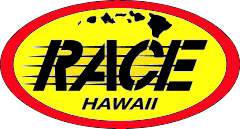Race Hawaii Double Bladed Stand Up Paddle Review
This is written by Darin Leong (http://www.hawaiiguitar.com/), my brother and a local attorney in Hawaii.

The double paddle took 30 minutes off my downwind time on the Hawaii Kai run (Portlock to Waikiki). For a downwind paddler like myself who often cannot pull into bumps with a single paddle, the double paddle gives that extra speed necessary to catch those bumps, turning an ok downwind run into an epic one.
Here’s a quick video with Evan surfing using the double bladed paddle.

(click thumbnail to launch video)
How it Works
The double paddle allows you to take (almost) two strokes for every one stroke that you would take with a single paddle. Single paddle strokes require the stroke and a recovery (out of the water). With the double paddle, when one blade exits the water, the opposite blade is ready to immediately enter the water, so you virtually eliminate the recovery. The result is a higher stroke rate. In addition, when one blade is in the water, the other blade is coming over the top, helping to propel the blade in the water forward.
The double paddle also feels different than a single paddle. For starters, you stay centered the entire time (and never switch sides). This constant centered balance helps racing boards plane smoother for longer glides. In addition, the double paddle stroke is different. It is more akin to one of those arm cycling machines that physical therapists use to rehab shoulders. The constant arm cycling tends to increase the cardio aspect of the workout more than a single paddle. Also, the length of the double paddle allows you to stand higher and initiate the catch of the stroke farther in front. All good things (I think) for downwind runs.
Downwind Runs
The double paddle took about 30 minutes off of my downwind time, instantly. I went from 1:50 to 1:20 by simply switching paddles. The reason: I caught way more bumps. With a single paddle and my less-than-stellar technique, I had a hard time pulling into bumps for much of the Hawaii Kai downwind run (unless the conditions were perfect). I had to lean forward and bend my back to force myself into bumps, but that technique compressed the board so the glides were short. With the double paddle, I’m able to stand tall while generating more speed to make the board plane above the water. Now I’m catching all kinds of bumps that I could never catch before. I also find that the board is planing higher on the bumps which allows for more speed and longer rides.
Flatwater Paddling
The double paddle also offers advantages for flatwater paddling. It gives more of a cardio workout, you can stand taller, you don’t have to switch sides, and you don’t have to deal with the board going side to side. Of course, the double paddle looks rather unconventional, so if you are into a more traditional approach, the single paddle may still be the way to go.
Surfing
The double paddle is a lot of fun in small waves with little to no wind. However, I don’t really recommend it for larger waves or in windy conditions. The size of the paddle makes it a bit more prone to damage in windy or big conditions if you fall off the board or get worked by a wave. However, in small surf on calm days, the double paddle makes for a fun change of pace. Just be careful not to damage your board or the paddle when you fall off the board.
Conclusion
The double paddle is amazing for downwind runs. It takes mediocre wind conditions and makes the run feel epic. The double paddle is also suitable for flatwater paddling and provides a good cardio workout. In the surf, the double paddle can work in small waves with no wind, but becomes a little unwieldy in bigger surf or on windy days.



0 Responses to “Race Hawaii Double Bladed Stand Up Paddle Review”